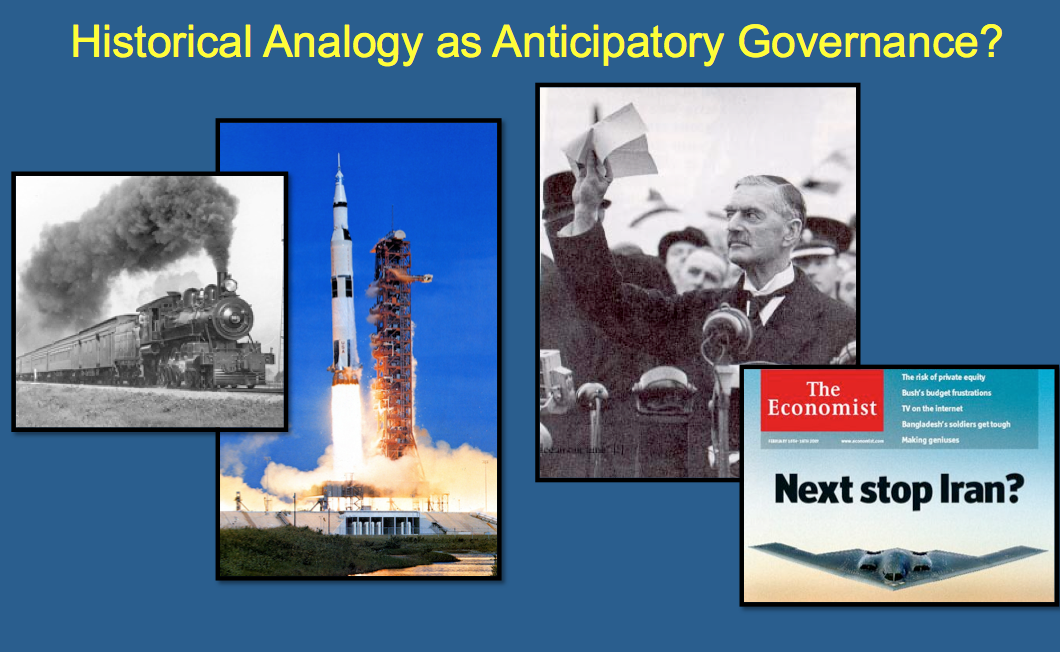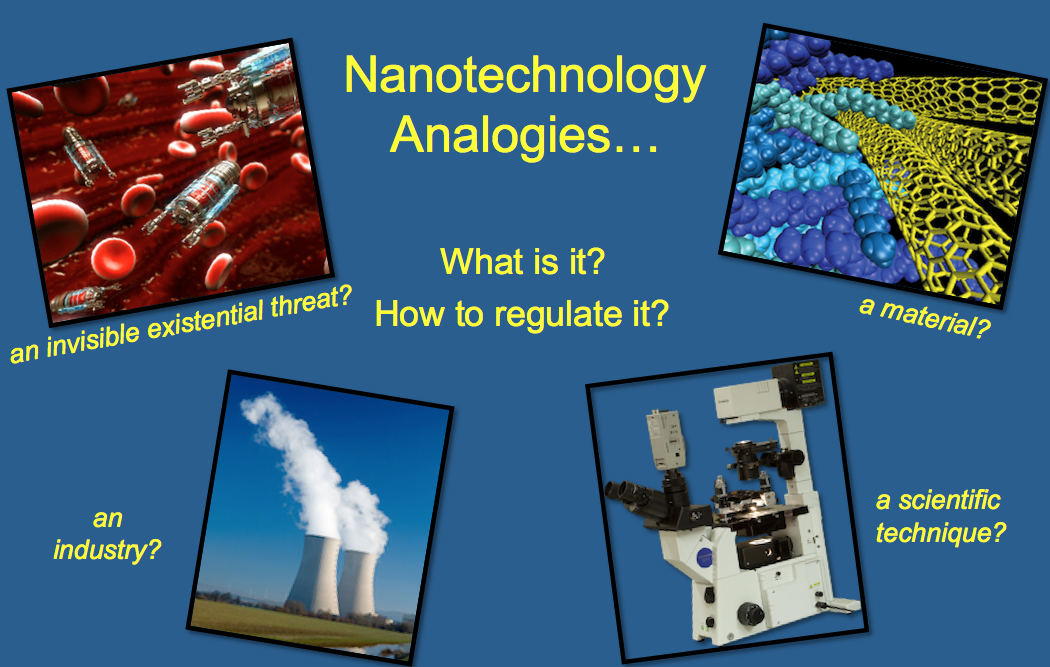Regulating Nanotechnology Via Analogy, Pt. 1
[Blogger’s note: This post is adapted from a talk I gave in March 2012 at the annual Business History Conference; it draws on research done by Roger Eardley-Pryor, an almost-finished graduate student I'm advising at UCSB, and me. I'm posting it here with his permission. This is the first of a two-part essay...some of the images come from slides we put together for the talk.] Over the last decade, a range of actors – scientists, policy makers, and activists – have used historical analogies to suggest different ways that risks associated with nanotechnology – especially those concerned with potential environmental implications – might be minimized. Some of these analogies make sense…others, while perhaps effective, are based on a less than ideal reading of history.Analogies have been used before as tools to evaluate new technologies. In 1965, NASA requested comparisons between the American railroad of the 19th century and the space program. In response, MIT historian Bruce Mazlish wrote a classic article that analyzed the utility and limitations of historical analogies. ((Bruce Mazlish, “Historical Analogy: The Railroad and the Space Program and Their Impact on Society,” in The Railroad and the Space Program: An Exploration in Historical Analogy, edited by Bruce Mazlish (Cambridge, MA: M.I.T. Press, 1965), pp. 1-52.)) Analogies, he explained, function as both model and myth. Mythically, they offer meaning and emotional security through an original archetype of familiar knowledge. Analogies also furnish models for understanding by construing either a structural or a functional relationship. As such, analogies function as devices of anticipation which what today is fashionably called “anticipatory governance.” ((Daniel Barben, Erik Fisher, Cynthia Selin, and David H. Guston, “Anticipatory Governance of Nanotechnology,” in The Handbook of Science and Technology Studies, Third Edition, edited by Edward J. Hackett, Olga Amsterdamska, Michael Lynch, and Judy Wajcman (Cambridge, MA: MIT Press, 2008), 979-1000.)) They also can serve as a useful tool for risk experts. ((Scott Knowles at Drexel University has a great book out on the role of "disaster experts" in modern America that is worth looking at.))
Over the last decade, a range of actors – scientists, policy makers, and activists – have used historical analogies to suggest different ways that risks associated with nanotechnology – especially those concerned with potential environmental implications – might be minimized. Some of these analogies make sense…others, while perhaps effective, are based on a less than ideal reading of history.Analogies have been used before as tools to evaluate new technologies. In 1965, NASA requested comparisons between the American railroad of the 19th century and the space program. In response, MIT historian Bruce Mazlish wrote a classic article that analyzed the utility and limitations of historical analogies. ((Bruce Mazlish, “Historical Analogy: The Railroad and the Space Program and Their Impact on Society,” in The Railroad and the Space Program: An Exploration in Historical Analogy, edited by Bruce Mazlish (Cambridge, MA: M.I.T. Press, 1965), pp. 1-52.)) Analogies, he explained, function as both model and myth. Mythically, they offer meaning and emotional security through an original archetype of familiar knowledge. Analogies also furnish models for understanding by construing either a structural or a functional relationship. As such, analogies function as devices of anticipation which what today is fashionably called “anticipatory governance.” ((Daniel Barben, Erik Fisher, Cynthia Selin, and David H. Guston, “Anticipatory Governance of Nanotechnology,” in The Handbook of Science and Technology Studies, Third Edition, edited by Edward J. Hackett, Olga Amsterdamska, Michael Lynch, and Judy Wajcman (Cambridge, MA: MIT Press, 2008), 979-1000.)) They also can serve as a useful tool for risk experts. ((Scott Knowles at Drexel University has a great book out on the role of "disaster experts" in modern America that is worth looking at.)) Policy makers recognize the importance of analogies. In 2003, participants at an NSF-sponsored workshop on nanotechnology’s societal implications warned that “one of the more disturbing possibilities is that policy makers and leaders of social movements may respond to nanotechnology not as it actually is, but in terms of false analogies.” ((“Workshop Breakout Session Reports,” in Nanotechnology: Societal Implications I, Maximizing Benefits for Humanity, edited by Mihail C. Roco and William Sims Bainbridge (Dordrecht, The Netherlands: Springer, 2007), 73.)) In 2003, policy makers and scientists were especially concerned about the public perceptions of nano.When the U.S. government first launched its National Nanotechnology Initiative in 2000, few if any policy makers expressed concerns about its environmental implications. ((When the National Academies of Science reviewed the NNI in 2002, its report shows that, out of $464 million allocated for nano in FY2001, less than 1% went to the Environmental Protection Agency. NAS, Small Wonders, Endless Frontiers report, 2002.)) But by 2003, it was impossible for the people charged with managing nano to have ignored its environmental, health, and safety issues. So how did EHS issues get on the radar screen of policy makers and journalists? There are several causal factors; their common feature is that they all originated not in the laboratory but in the realms of popular culture, celebrity, and social activism.An early shot across the bows came from an unexpected source. Bill Joy was a Berkeley-trained computer researcher and dot-com millionaire. His incendiary article – published by Wired in April 2000 – was titled “Why the Future Doesn’t Need Us.” It highlighted perils he saw in several emerging technologies. Motivated partly by controversies over corporate development of genetically-modified crops, Joy identified self-replication of newly emerging nanotechnologies as a clear and future danger. The solution? Joy proposed “relinquishment” and limiting development of “technologies that are too dangerous.” Accompanied by a flurry of international publicity, Joy’s article came at an inconvenient time for nano-boosters as Congress was preparing to vote on Clinton’s proposed new national nano initiative in 2000. Controversy stirred by articles like Joy's threatened this initiative.Nano-anxieties were fanned anew in late 2002 when HarperCollins published Prey by blockbuster novelist Michael Crichton. Central to its plot was the deliberate release of autonomous, self-replicating nanobots. Created by an amoral corporation working under contract to the Pentagon, the predatory swarm of millions of nanobots attacked people until it was destroyed. Crichton’s book hit every button that might stoke public alarm about nanotechnology: a greedy, high-tech firm; lack of government regulation; new technologies turned into military applications.Non-governmental organizations helped keep controversies over nanotechnology in front of North American and European citizens. In January 2003, the Action Group on Erosion, Technology, and Concentration (ETC), a small Canadian NGO, released a report called The Big Down.
Policy makers recognize the importance of analogies. In 2003, participants at an NSF-sponsored workshop on nanotechnology’s societal implications warned that “one of the more disturbing possibilities is that policy makers and leaders of social movements may respond to nanotechnology not as it actually is, but in terms of false analogies.” ((“Workshop Breakout Session Reports,” in Nanotechnology: Societal Implications I, Maximizing Benefits for Humanity, edited by Mihail C. Roco and William Sims Bainbridge (Dordrecht, The Netherlands: Springer, 2007), 73.)) In 2003, policy makers and scientists were especially concerned about the public perceptions of nano.When the U.S. government first launched its National Nanotechnology Initiative in 2000, few if any policy makers expressed concerns about its environmental implications. ((When the National Academies of Science reviewed the NNI in 2002, its report shows that, out of $464 million allocated for nano in FY2001, less than 1% went to the Environmental Protection Agency. NAS, Small Wonders, Endless Frontiers report, 2002.)) But by 2003, it was impossible for the people charged with managing nano to have ignored its environmental, health, and safety issues. So how did EHS issues get on the radar screen of policy makers and journalists? There are several causal factors; their common feature is that they all originated not in the laboratory but in the realms of popular culture, celebrity, and social activism.An early shot across the bows came from an unexpected source. Bill Joy was a Berkeley-trained computer researcher and dot-com millionaire. His incendiary article – published by Wired in April 2000 – was titled “Why the Future Doesn’t Need Us.” It highlighted perils he saw in several emerging technologies. Motivated partly by controversies over corporate development of genetically-modified crops, Joy identified self-replication of newly emerging nanotechnologies as a clear and future danger. The solution? Joy proposed “relinquishment” and limiting development of “technologies that are too dangerous.” Accompanied by a flurry of international publicity, Joy’s article came at an inconvenient time for nano-boosters as Congress was preparing to vote on Clinton’s proposed new national nano initiative in 2000. Controversy stirred by articles like Joy's threatened this initiative.Nano-anxieties were fanned anew in late 2002 when HarperCollins published Prey by blockbuster novelist Michael Crichton. Central to its plot was the deliberate release of autonomous, self-replicating nanobots. Created by an amoral corporation working under contract to the Pentagon, the predatory swarm of millions of nanobots attacked people until it was destroyed. Crichton’s book hit every button that might stoke public alarm about nanotechnology: a greedy, high-tech firm; lack of government regulation; new technologies turned into military applications.Non-governmental organizations helped keep controversies over nanotechnology in front of North American and European citizens. In January 2003, the Action Group on Erosion, Technology, and Concentration (ETC), a small Canadian NGO, released a report called The Big Down. ETC had previously led campaigns against genetically modified foods. Not surprisingly, their report savaged the idea of nanotechnology. ETC’s report reflected the group’s larger agenda, which was less about so-called emerging technologies per se and more about restricting corporate power and maintaining cultural diversity and human rights.But none of the examples was about a specific existing technology. Instead, these spurs to regulation referred to hypothetical technologies and the creation of planet-threatening dangers. Soon however, concerns about nano’s regulation transcended vague existential threats and moved to specific and potentially troubling techniques and materials.But what exactly was to be regulated? Was nanotechnology something with the capacity to spread across wide swaths of land and reap tremendous environmental damage with the fear amplified in part because of its minute size? Or perhaps nanotechnology was less an existential threat and instead a suite of scientific techniques and tools that require regulation? If not a particular technique, was nanotechnology a particular product, a specific category of material, a hazardous form of matter that should be controlled for the health and safety of workers and consumers? Or, did nanotechnology represent an entire new industry in need of care and control in order to reap its economic benefits?
ETC had previously led campaigns against genetically modified foods. Not surprisingly, their report savaged the idea of nanotechnology. ETC’s report reflected the group’s larger agenda, which was less about so-called emerging technologies per se and more about restricting corporate power and maintaining cultural diversity and human rights.But none of the examples was about a specific existing technology. Instead, these spurs to regulation referred to hypothetical technologies and the creation of planet-threatening dangers. Soon however, concerns about nano’s regulation transcended vague existential threats and moved to specific and potentially troubling techniques and materials.But what exactly was to be regulated? Was nanotechnology something with the capacity to spread across wide swaths of land and reap tremendous environmental damage with the fear amplified in part because of its minute size? Or perhaps nanotechnology was less an existential threat and instead a suite of scientific techniques and tools that require regulation? If not a particular technique, was nanotechnology a particular product, a specific category of material, a hazardous form of matter that should be controlled for the health and safety of workers and consumers? Or, did nanotechnology represent an entire new industry in need of care and control in order to reap its economic benefits? So…in order to draw fitting analogies that might suggest an ideal path toward the appropriate oversight or regulation of nanotechnology, stakeholders first had to agree on its definition. And depending on what definition one chose, a different historical analogy could be found which suggested a different approach to regulation…more on this next time. But, to give a hint, the frequent comparisons between nano and genetically-modified organisms were not necessarily the best way to build a regulatory policy. ((A rhetorically powerful example of this came from 2003 Congressional testimony given by Rice University chemist Vicki Colvin. Colvin, director of Rice's Center for Biological and Environmental Nanotechnology, spoke about societal implications of nanotechnology. This “emerging technology,” Colvin said, had a considerable “wow index.”Nanotech offered “potential benefits to the economy, human health, and quality of life.” However, Colvin warned, every new such emerging technology came with its own particular set of concerns. If improperly handled, these concerns “can turn wow into yuck and ultimately into bankrupt.” To drive her point home, Colvin shrewdly drew an analogy between a future in which nano might go bankrupt and an example that would resonate with policy makers – the “genetically modified foods industry.” A quick web search on “Vicki Colvin + wow to yuck” yields some 360,000 hits including several presentations and papers she and her Rice colleagues gave that use the phrase. Her original testimony appears in House of Representatives Committee on Science, “The Societal Implications of Nanotechnology,” Hearing before the Committee on Science, House of Representatives (108th Congress, 1st Session), April 9, 2003.))To be continued…
So…in order to draw fitting analogies that might suggest an ideal path toward the appropriate oversight or regulation of nanotechnology, stakeholders first had to agree on its definition. And depending on what definition one chose, a different historical analogy could be found which suggested a different approach to regulation…more on this next time. But, to give a hint, the frequent comparisons between nano and genetically-modified organisms were not necessarily the best way to build a regulatory policy. ((A rhetorically powerful example of this came from 2003 Congressional testimony given by Rice University chemist Vicki Colvin. Colvin, director of Rice's Center for Biological and Environmental Nanotechnology, spoke about societal implications of nanotechnology. This “emerging technology,” Colvin said, had a considerable “wow index.”Nanotech offered “potential benefits to the economy, human health, and quality of life.” However, Colvin warned, every new such emerging technology came with its own particular set of concerns. If improperly handled, these concerns “can turn wow into yuck and ultimately into bankrupt.” To drive her point home, Colvin shrewdly drew an analogy between a future in which nano might go bankrupt and an example that would resonate with policy makers – the “genetically modified foods industry.” A quick web search on “Vicki Colvin + wow to yuck” yields some 360,000 hits including several presentations and papers she and her Rice colleagues gave that use the phrase. Her original testimony appears in House of Representatives Committee on Science, “The Societal Implications of Nanotechnology,” Hearing before the Committee on Science, House of Representatives (108th Congress, 1st Session), April 9, 2003.))To be continued…